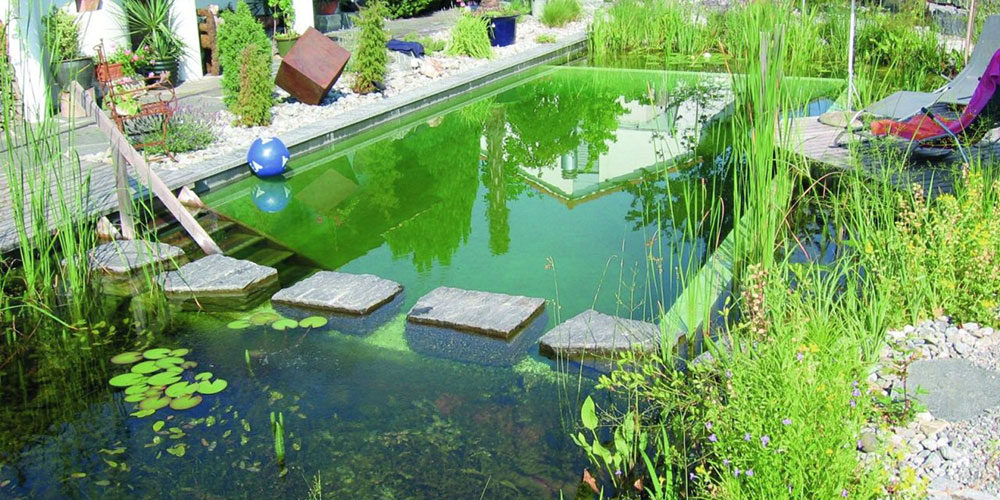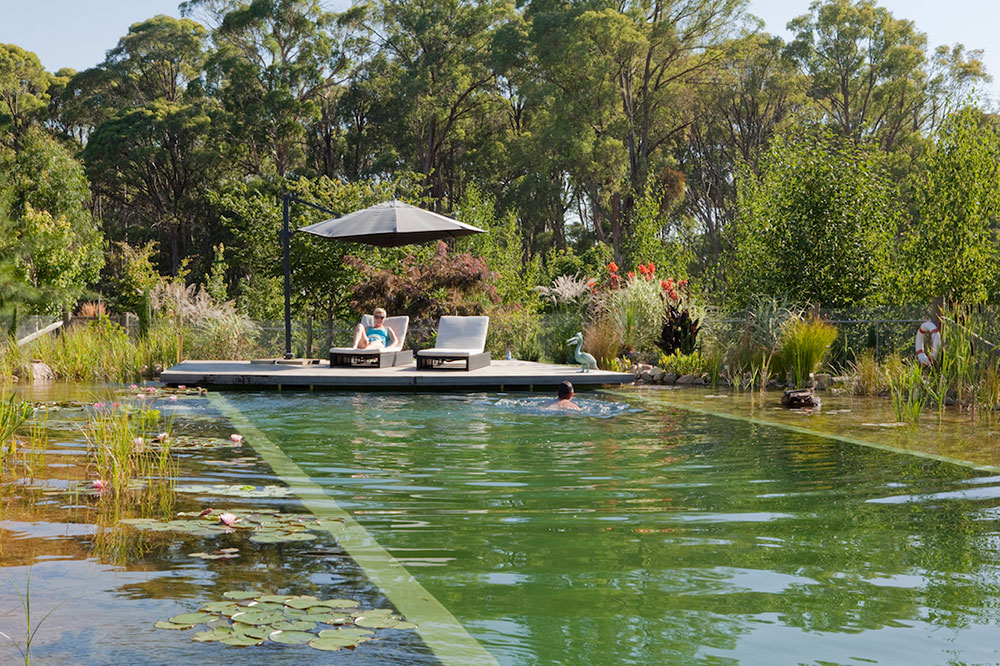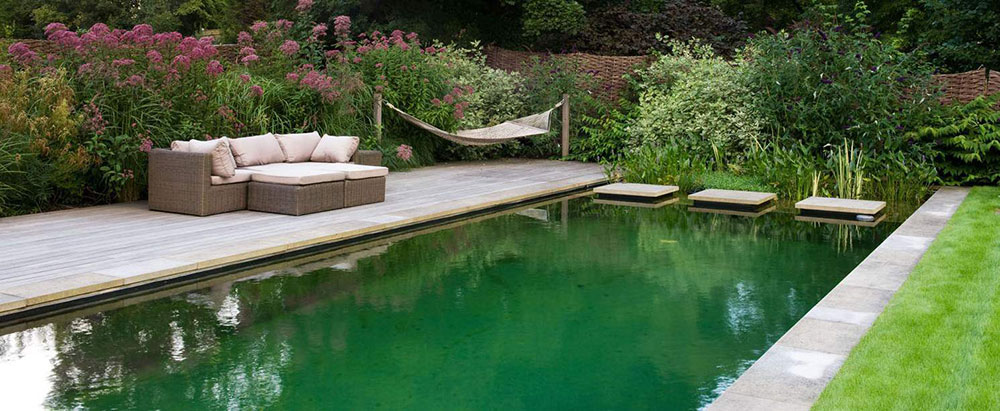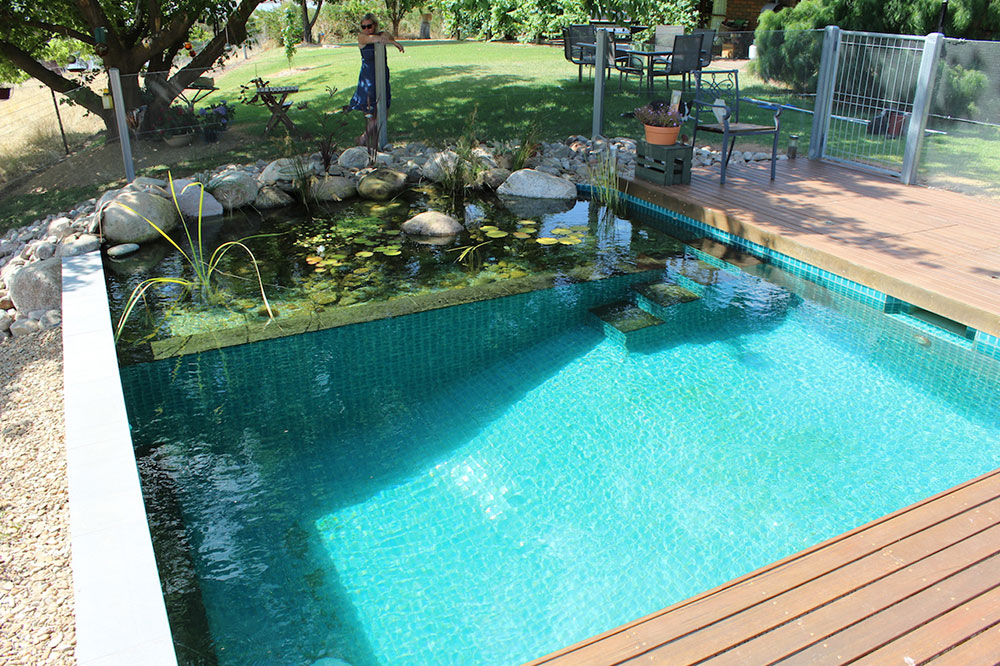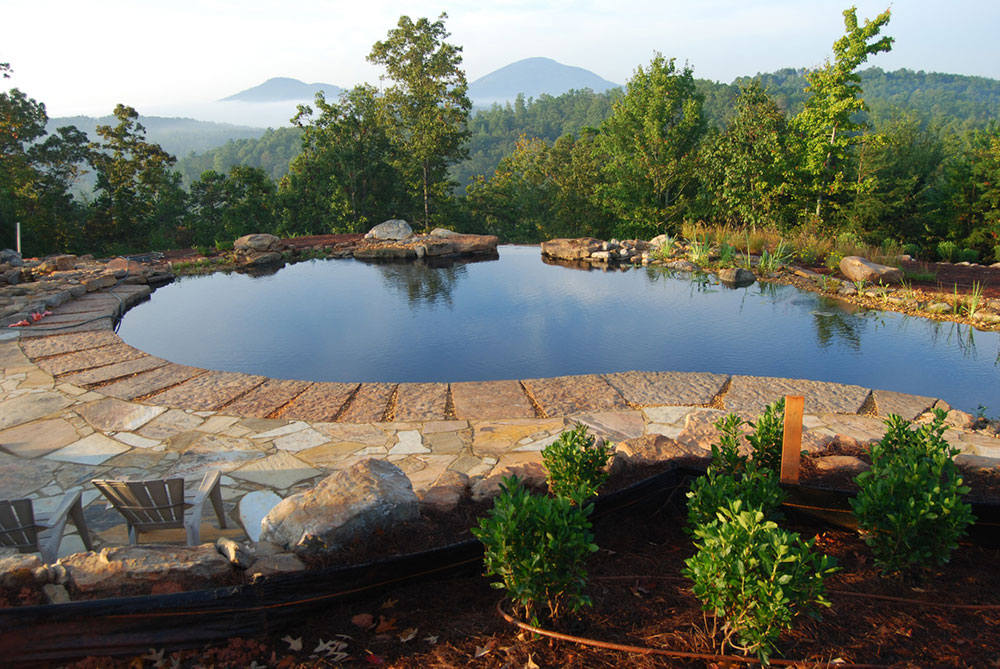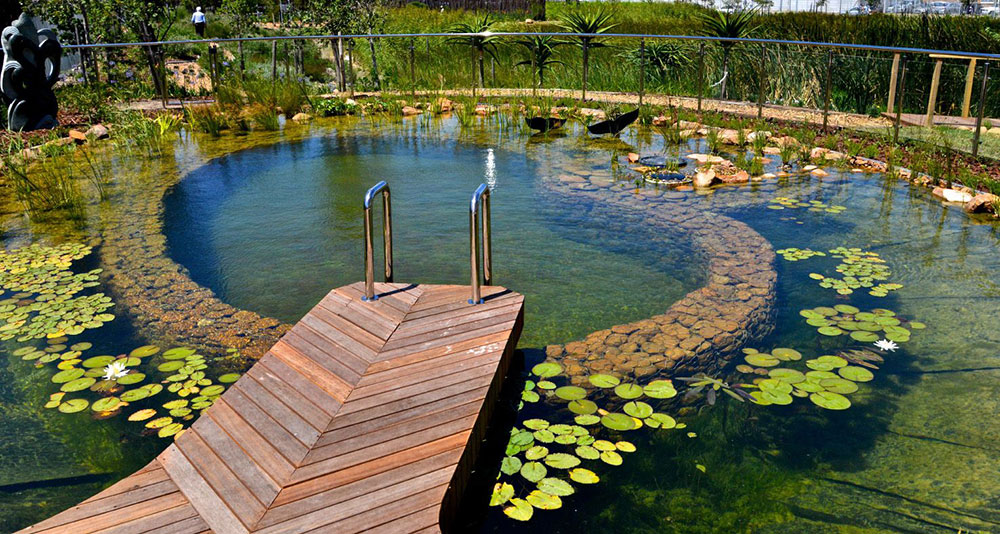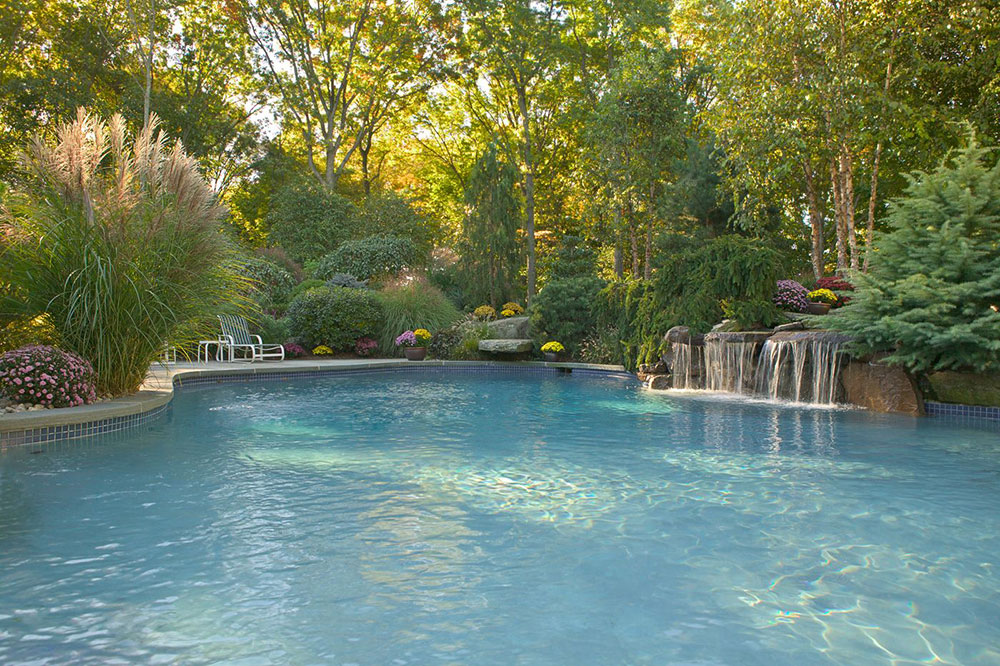Advertisement
How does the idea of a natural swimming pool sound? Is there enough room in your backyard to create one? Natural swimming pools are the hottest green living trend, and they definitely deserve a second thought.
Your natural swimming pool can be either simple or really complex – it depends on how much you’re ready to spend on it. It is true that such pools cost more than regular ones, but they provide you the pleasure of being surrounded by natural habitat.
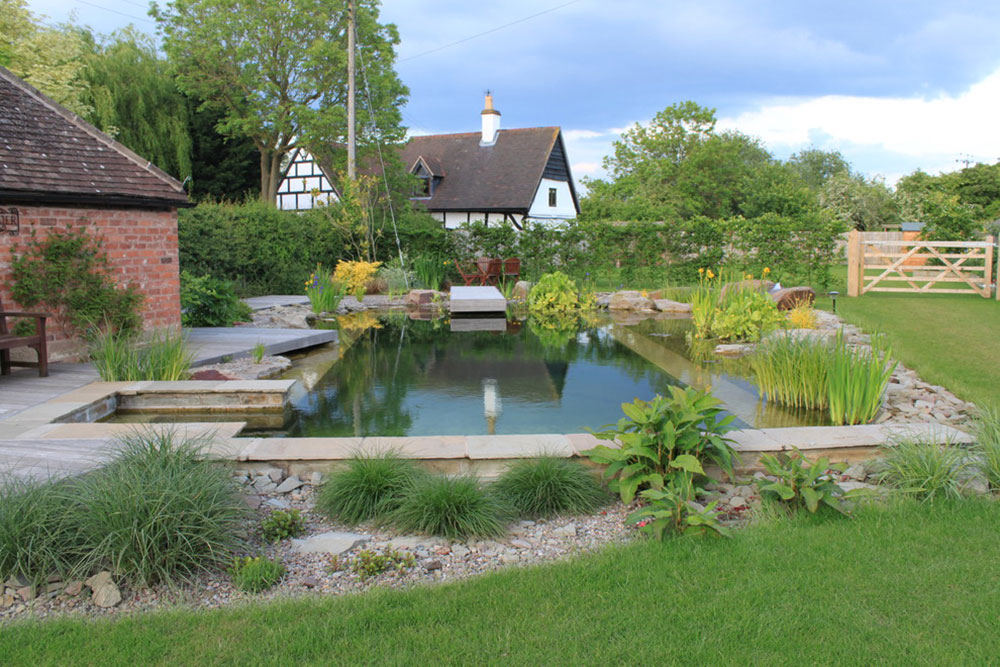
Image source: Keyscape Landscape Design & Construction Ltd
Choosing a natural swimming pool, you won’t have to worry about chemicals, but just enjoy clear water circulating through soil, rocks, and plants. Such a little relaxing haven!
The best news is you don’t have to be an experienced contractor to make this dream come true, and to have a natural pool everyone will admire! Here’s how:
The first decision you have to make is whether you’re building a swimming pond, or a DIY natural swimming pool.
If you prefer a wild swimming environment with low-tech pool and lots of plants, we’d recommend a swimming pond. Unlike a DIY pool, it will emulate a genuine ‘swimming in the wildness’ feeling, and look nothing alike modern pool settings.
Yet, you need to be aware that the design characteristics of such pond are very specific – they are complex to build, and require carefully planted and well-maintained regeneration zones.
The other option you’ve got is to build a natural swimming pool that is wildlife free, but also clear and with no chemicals to worry about. These pools let you be as creative when designing them as you want, and you can warm them up upon need.
Here are some useful tips to keep in mind when building a unique and cost-effective natural swimming pool:
Go for a simpler design
The design and features of a truly natural swimming pool should be simple. Indeed – the pool will look far more impressive with large stone structures and waterfalls, but those are neither cheap to execute nor easy to maintain. Instead, you can add interest with plants and wildlife, or create beautiful stone steps that lead to the natural pools.
Ideas, nonetheless, come along as you’re working, so it is very likely that you will go off the rails. To avoid it, follow our tips:
- Go for a simple shape
- Settle the basics first, and only then think of the extras
- Make a step-by-step plan for each stage of the construction process
- Put some extra money aside in case you forget to do something (or in case you decide to hire professional help)
- Take your time – this process is not simple, so keep your schedule realistic.
Don’t expect too much
Even when you have some extra money to spend, keep your expectations low. Try to figure out exactly how much space, time, or money you will need to build your own pool.
Prepare yourself
So, how to make a pool? Planning and ordering materials in advance will help you stay true to your schedule, as you won’t have to wait for features to be delivered.
We know that planning an organic pool can be challenging at a stage where you don’t really know what you need. Therefore, we’ve listed the basic items you need to build a new natural swimming pool:
The materials:
- Cement
- Gravel
- Sand
- Formwork, bars, and boards
- Liquid glass
- Clay
- Fittings
The tools:
- Hacksaws
- Shovel
- Hammer
- Level
- Plumb
- Mixer
- Pliers
This is only the basic list of items for your organic pools building project. Depending on what you want, you will also need additional features, tools, and decorations; and you must count these in when planning your budget. If you’re not really sure what to order, ask for professional help.
Keep the bottom flat
Natural swimming pools should always have a flat bottom, as anything else would make the digging process too complicated. A flat natural swimming pool is also easier to clean, and safer to swim in.
Choosing flat bottoms over sloped sides maximizes the swimming space in your pool, and provides a safe, leveled foundation for the walls. Plus, it costs way less than any other design.
Go for a box shape
If you want a cheap pool, stick to the classics. Most swimming pools are rectangular or box in shape, and there is a good reason for that.
These shapes are the easiest and therefore most affordable to build, as you can easily find materials for them. Yet, you should check whether the tanking product contains phosphates, as these can feed algae and cause serious issues in the future.
You don’t need lots of fittings
Pipes and fittings are necessary to enable your pool to work, but they’re not pleasant for the eye. Since your swimming pool is supposed to look natural, plan a suitable location for each of these fixtures, and make sure they’re not visible to the swimmer. This may be problematic with a small pool to equip, but it is not impossible – think creatively, and you will come up with great ideas that don’t even cost much.
If willing to spend more, you can keep the piping structure fully underground, but keep in mind that you will have troubles repairing it.
The shallower the better
There is no doubt that depth enhances the swimming experience, but you should be aware of the fact that a deeper pool will automatically cost more. You’ll need to dig more, build higher walls around it, and reinforce them with an additional layer. All of this will also take more time.
What are the ideal walls for a natural swimming pool? We’d say – go for a maximum of 2 meters in height. Unless you’re planning to dive in it, 1.5 meters will do the job just fine. Plus, your pool will be easy to clean, and relatively painless to afford.
If not sure about the retaining walls, consult a structural engineer. Keep in mind that the weakest point of the walls is the one where they join the floor. Yet, you can minimize the use of steel by bolstering the walls with some additional concrete.
Having a deep pool will also shorten the swimming season, as water will be much colder than in a shallow pond. On the other hand, deeper pools are less prone to algae growth, so you won’t have to struggle with this issue.
Avoid concrete and prefabricated walls
If you bring the pool’s base up to shallower levels on the sizes, you can achieve some extra depth in the middle. To do that, you should hopper the bottom of the pool, and create walls out of stone or sand bags. Doing so will require some construction skills, so be careful how you use the flat liner. The last thing you need is an uneven pool that not only looks funny, but is also a safety hazard to swimmers.
Use a borehole or a well (if available)
Those among you lucky enough to have borehole water in the yard can fill their pool on the long run, and on the budget. Nonetheless, you have to examine the water and treat it until it is suitable for swimming, and you’ll most probably need expert help.
Use a black liner to make the most of sunlight
Since you’re working on a natural swimming pool, we guess you’d rather have the eco vibe on than installing multiple electric heaters. Here’s a smart tip for you: If you add a black liner, it will absorb the heat better than any other color, and you may not even have to install artificial heating. This way, your maintenance costs will be significantly reduced.
In addition, a black liner will give your pool an even more natural look, and help it blend completely within your backyard landscape. All in all, it will be the perfect finishing touch for your stylish project.
Since you’re into remaining natural (and on budget!), we advise you to use betonite clay. This material is the natural alternative to all synthetic liners, and costs significantly less.
Come up with the most efficient drainage plan possible
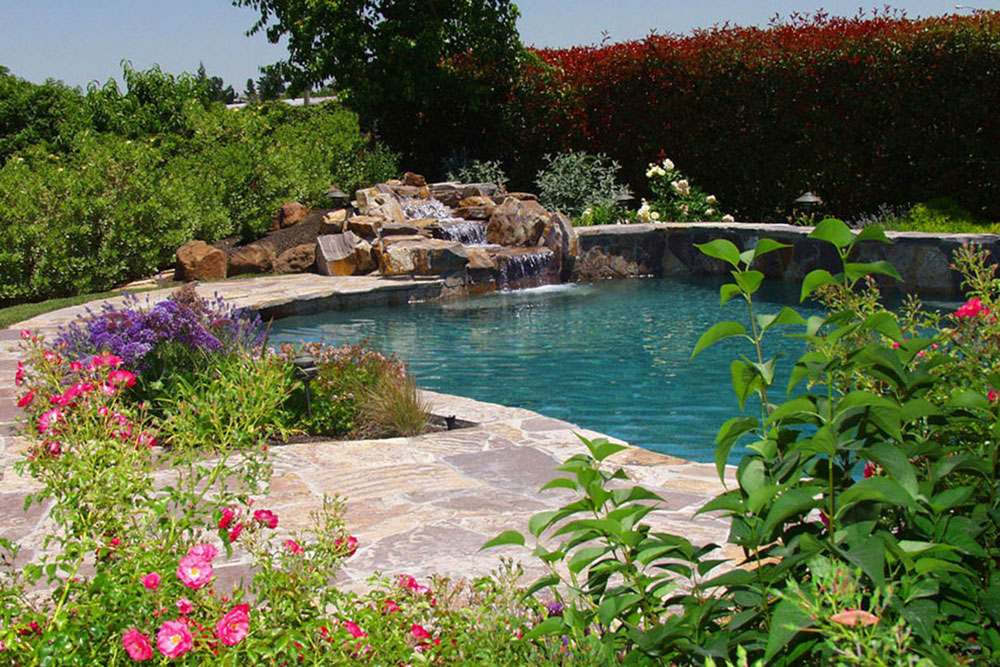 Image source: Swan Pools Bay Area
Image source: Swan Pools Bay Area
Building a pool is fun, but it can also be dangerous if handled the wrong way. The reason why so many pools fail is their poor drainage system. When planning the pool, you have to secure sufficient drainage, as this will save you plenty of repair work on the long run. There are many less troublesome points in your plan designing plan where you can save some money. Drainage is not one of them.
With a proper drainage plan, on the other hand, you will enable ground and surface water to move away from the pool. Here’s what we have in mind: the pool should be placed in an area other than the lowest level of your garden, as all other scenarios can cause flood.
Next, install quality drainage channels around the pool that will prevent water from sipping over. Needless to say, these channels should be designed and positioned in a way that follows the concept of your oasis.
A bonus tip: If you have a natural well, using it will be your best drainage alternative. Yet, it all depends on where it is placed.
Take some serious care of water quality
If you can, fill your homemade pool with spring water. This way, you won’t have to worry about the safety of your pool, and you can save a significant amount of money. In all other cases, you should do some extra work to ensure that the quality of the water is good.
Since natural pools devote at least 50% of the surface to natural vegetation, and their bottoms are lined with gravel layers, you may require a natural filtration system. This, however, doesn’t eliminate the chance of algae growth, and you’ll have to clean your pond pool constantly to avoid this from happening.
Natural filtration systems are not that expensive, and neither is the expert crew that will come to install them. The systems are actually circular pumps with gravel and plant filters that filter water all the time, and you should clean them once per month to get rid of loose sediment.
To save you some extra money, some of these systems are run by solar panels.
Place your plants strategically
First of all, choose plants that correspond to your climate. Your local native plant suppliers will certainly have some suggestions on which plants you should use.
Another cool idea is the incredibly popular aquatic plants which you can find in any home or garden center. We also suggest you browse the Internet to collect ideas on plan placement.
Here are some plants you can consider:
Sedges (Carex) and rushes (Scirpus) are both beautiful and aquatic plants, and they can be the perfect vegetation for the pool’s perimeter.
If you want something more original, consider aquatic irises or lesser cattails (Typhaangustifolia), but make sure that the varieties you’ve chosen are not a danger to the other plants you have. If looking to vegetate the lower areas of the pool, check the water primroses (Ludwigia), pickerel weed (Pontedeiacordata), and arrowhead (Sagittaria).
Next to them, you will need submerged plants with excellent oxygen output, such as hornwort (Ceratophyllum) or waterweed (Elodea).
In areas where the water is 6-18 inches deep, create a beautiful mash-up of submerged, floating, and surface plants.
There are also plants that adapt to any different depths, and you can use them everywhere you want – Your choices will be water lilies (Nymphaea), pondweeds (Potamogeton), common duckweed (Lemna minor), and many others.
Before investing into a truckload of greenery and expensive plants, take your time! Collecting plants from the closest country pond is also not an option, as there are a number of environmental laws that may be protecting those wetlands.
Even if allowed to collect plants on your own, try to do that as gently as you can in order to protect the health of the pond. Gather only a small number of samples, and leave unique plants that don’t belong to larger and threatened population. If you notice, however, that the environment is not good for these plants and that they are imperiled, rescue them! An idea would also be to call the authorities in charge and to report the case.
Once you have all plants you need and you’re ready to go, start vegetating your pool. Make a clear plan and stick to it, and make sure your greenery is positioned according to type, height, and ideally color. Once the plants are into the soil, anchor them with lots of gravel.
Don’t underestimate gravel
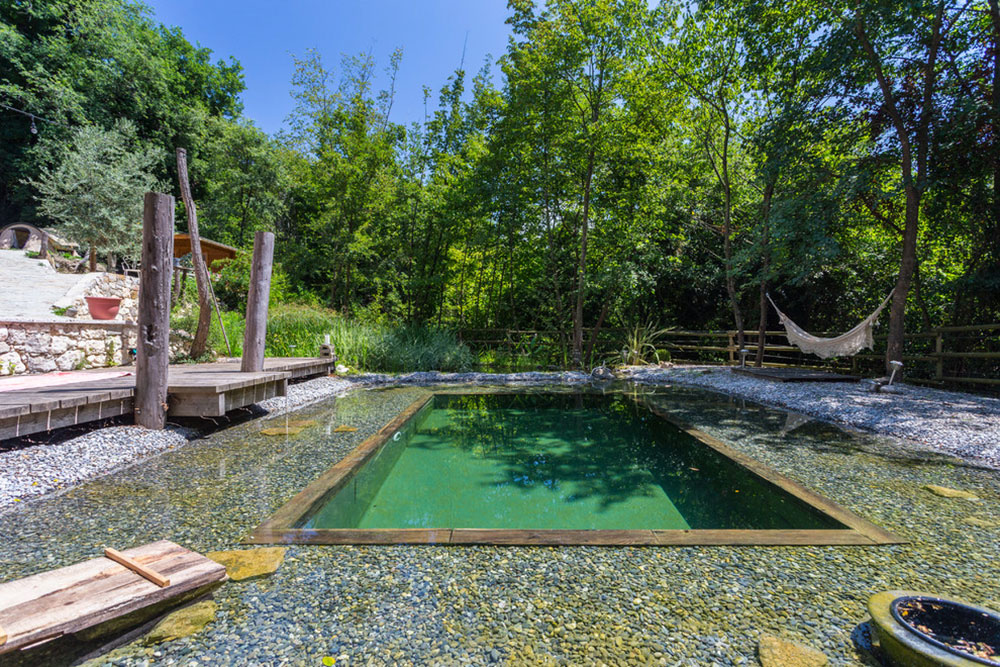 Image source: Franck Minieri Photographer
Image source: Franck Minieri Photographer
Many future functions of your water garden will depend on how well you’ve worked with gravel. To start with, you need to spread 4-5 inch layers of pea gravel over the pool liner, so that microorganisms have a place to thrive.
Another important function of gravel is to help organic plant materials fall apart as they reach the bottom. If gravel’s not there, they could create the perfect environment for algae growth.
The surface area should be as large as possible
The same as with depth, the surface area of your natural swimming pool should be large, so that you won’t experience an algae attack. The healthier pools are those with a minimum of 50 m2 cross area.
Don’t get the ‘zoning’ wrong
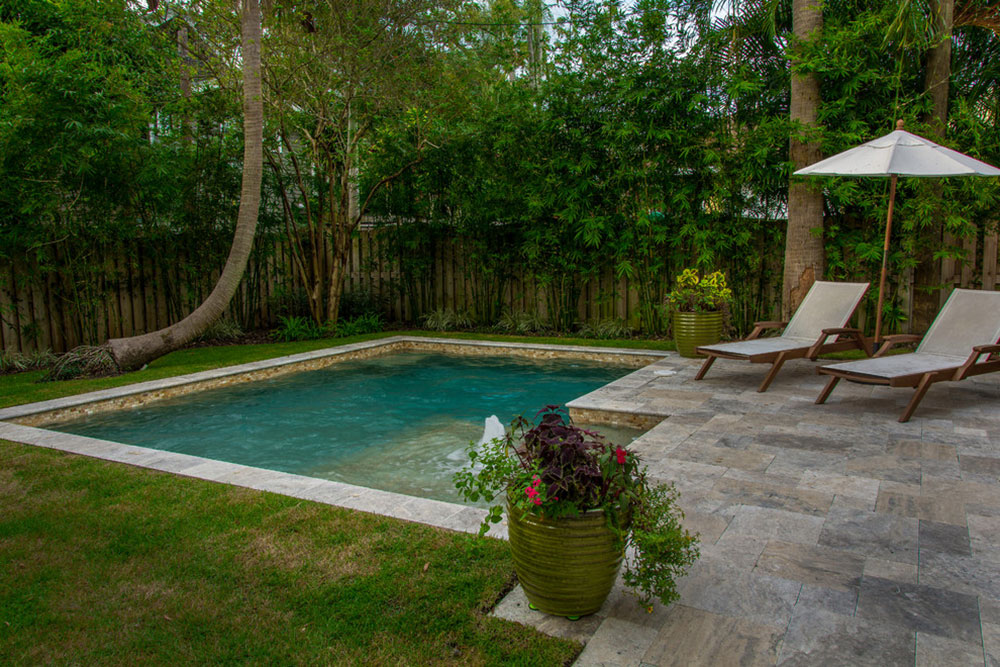 Image source: Landscape-Fusion
Image source: Landscape-Fusion
When calculating the space you need for a natural pool, don’t only consider the swimming area. Save some space around the pool for filters and vegetation, and reserve at least 50% of the total surface for shallow greenery. These plants support your ecosystem with excellent cleansing features – if you have enough of them, you may as well avoid investing in expensive filters and chlorine. Needless to say, they look amazingly cute!
Here comes a bonus tip:
Since you’re just beginning to plan your natural pool, consider all features in the development area, including this additional space for filtering and vegetation.
This way, you will know exactly what you can and what you cannot build and you won’t underestimate the space you have available. Basically, a perfect natural swimming pool depends on how you’ve planned to build it.
How to deal with algae growth in your pool
Dealing with the mighty green menace is the ultimate battle of every pool owner. As a natural swimming pool owner, you’ll want to get rid of algae not just because they don’t look nice, but also because they use the nutrients and light that are supposed to feed your plants. The plants, of course, have a mechanism to defend themselves against algae, but that doesn’t mean you don’t need to help them.
The best way to deter algae is to bring in as many plants as you can, and to maintain a normal pH level (5.5-6.5) by eliminating phosphorous. Adding plants and letting them out-compete for nutrients is the safest way to protect your aquatic ecosystem, but if that doesn’t work you’ll have to keep an eye on phosphorus level. Note that the major sources of this algae nutrient are urine and fertilizers, so warn people to use the bathroom before they go inside the pool. In order to stimulate some biological activity, you can also make aeration more frequent.
How to maintain a natural swimming pool
If you want to prolong the life of your well-vegetated natural swimming pool, make sure you remove plant litter at least twice a year. The level of the water should always be the same, even if that means adding water upon need.
Get some test kits to examine the pH level – you can find these in all garden centers, and you don’t even have to pay too much for them. At the same time, they will alert you on problems you know nothing about, and which may endanger the safety of your natural swimming pool.
The biological health of your pool is not everything you have to think about. You also need to control the mechanical systems at least once per year. For instance, you should examine the air hoses to confirm there are no cracks and obstructions, remove deposits by wiping your diffusers with vinegar, and examine the connections to your pumps on regular basis. If you consider these precautions, you’ll have a beautiful natural swimming pool to enjoy for years ahead.
There they are – out easy and useful tips on building a beautiful DIY natural swimming pool! Next – relax and enjoy some fun time with your family!
FAQs about DIY natural swimming pools
1. What is a DIY natural swimming pool?
A DIY natural swimming pool is one that uses no chemicals and is made to resemble nature as closely as possible. A natural swimming pool employs a variety of plants, filters, and microorganisms in place of chlorine to keep the water clean and suitable for swimming.
2. What are the benefits of having a natural swimming pool?
A natural swimming pool has a number of advantages, such as a chemical-free swimming environment, increased backyard biodiversity, and the capacity to design a stunning natural sanctuary. Additionally, natural swimming pools need less upkeep and eventually become more affordable.
3. How do you build a natural swimming pool?
To construct a natural swimming pool, you must excavate a hole and divide it into two sections: one for plants and the other for swimming. The plant area filters the water naturally by removing pollutants. After construction, the pool is filled with water and the plants and microbes are added.
4. Can you convert an existing pool into a natural swimming pool?
A current pool can absolutely be transformed into a natural swimming pool. The procedure, meanwhile, can be more difficult than starting from scratch with a brand-new natural pool. In order to convert an existing pool, the liner or concrete must typically be removed and replaced with a natural pool liner or a specially formulated concrete mix that is plant-safe.
5. What kind of plants are best for a natural swimming pool?
A natural swimming pool can be planted with a variety of plants. Irises, water hyacinths, and water lilies are a few common options. These plants create a lovely natural landscape while helping to filter and keep the water clean.
6. How do you keep the water in a natural swimming pool clean and clear?
A proper combination of plants, filters, and microbes is necessary to keep the water in a natural swimming pool clear and clean. This entails routinely testing the pH levels of the water and adjusting them as necessary, as well as cleaning the pool filter and skimming any debris from the water’s surface.
7. Is a natural swimming pool more expensive to build than a traditional pool?
The size of the pool and the materials used are just two of the many variables that might affect the price of developing a natural swimming pool. However, due to the specific tools and materials needed, building a natural swimming pool can generally be more expensive than building a regular pool.
8. How much maintenance does a natural swimming pool require?
An organic swimming pool often needs less upkeep than a conventional pool. It still needs some routine maintenance, such as cleaning the filter, skimming trash off the water’s surface, and trimming the plants. Depending on the size of the pool and the climate where it is located, different amounts of upkeep may be necessary.
9. Can you swim in a natural swimming pool year-round?
The majority of the time, a natural swimming pool is intended to be utilized in the summer when the water is warm enough for swimming. However, it would be possible to use a natural swimming pool all year round in some regions with mild weather.
10. Are natural swimming pools safe for children and pets?
Yes, both kids and pets can swim in natural pools. Due to the absence of dangerous chemicals in the water, they may even be safer than conventional swimming pools. As with any swimming pool, it is crucial to keep an eye on kids and animals as they swim to protect their safety.

